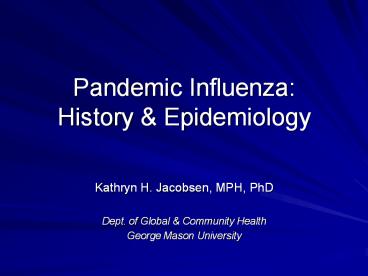Pandemic Influenza: History & Epidemiology - PowerPoint PPT Presentation
1 / 18
Title:
Pandemic Influenza: History & Epidemiology
Description:
Pandemic Influenza: History & Epidemiology Kathryn H. Jacobsen, MPH, PhD Dept. of Global & Community Health George Mason University What is normal flu? – PowerPoint PPT presentation
Number of Views:113
Avg rating:3.0/5.0
Title: Pandemic Influenza: History & Epidemiology
1
Pandemic Influenza History Epidemiology
- Kathryn H. Jacobsen, MPH, PhD
- Dept. of Global Community Health
- George Mason University
2
What is normal flu?
- Respiratory disease
- Symptoms fever, muscle aches, cough, sore
throat, runny nose, and possible nausea - May develop into pneumonia
- Spread by airborne droplets that reach the eyes,
nose, or mouth may also be spread by touching
contaminated surfaces and then the face - The elderly, very young, and those with weakened
immune systems are at risk of severe illness
(especially pneumonia) and death. - 30,000 40,000 deaths in the USA in a normal
flu year (and 5 20 of the population sick)
3
Why are we susceptible to new flu strains?
Antigenic Drift
- Influenza viruses frequently mutate (antigenic
drift). - Surface proteins change in ways that make it
difficult for our immune systems to quickly
identify them and fight them off. - A new flu vaccine is developed every year to
adjust for the changes in the circulating flu
viruses.
4
Why are we susceptible to new flu strains?
Antigenic Shift
- Two very different types of flu virus that infect
one animal can merge to create a completely new
strain (antigenic shift). - Most common strain in humans in recent decades
H3N2 - Bird flu H5N1
Domestic birds
Domestic pigs
Humans
5
What is bird flu?
- Many flu strains are bird flu or pig flu,
etc. - Avian influenza H5N1 is a flu virus type that
primarily affects birds highly contagious in
birds and has resulted in many bird deaths - Bird flu is species specific and rarely infects
humans only a few hundred humans are known to
have contracted H5N1 - Genetic changes may cause H5N1 to develop the
ability to more easily infect humans
Domestic birds
Domestic pigs
Humans
Wild birds
6
Why are we concerned about H5N1?
- Most humans have no immunity to H5N1
- About half of the humans known to have been
infected with H5N1 have died. - Important note This is an overestimation of the
true case fatality rate because only severe cases
are tested. - All had direct and prolonged contact with poultry
or bird habitats. - Most cases have occurred in children and young
adults.
7
Why are we concerned about a possible pandemic?
- Conditions for a pandemic
- (1) Emergence of a new flu strain
- (2) Ability of the strain to infect humans and
cause severe illness - (3) Ability to spread easily among humans
- If further mutations of the H5N1 virus occur and
the virus becomes easy to transmit from human to
human a global outbreak (pandemic) could occur.
8
WHO Pandemic Staging
- Interpandemic Period
- Phase 1 Low Risk No new influenza virus
subtypes in humans - Phase 2 New Virus No new flu in humans but an
animal variant emerges - Pandemic Alert Period
- Phase 3 Self Limiting Human infections but no
human-to-human transmission - Phase 4 Person-to-Person Small clusters with
limited human-to-human transmission - Phase 5 - Epidemic Larger but still localized
clusters - Pandemic Period
- Phase 6 - Pandemic Increased and sustained
transmission in the general population
9
Pandemics (Global Epidemics) in History
- 541 CE, bubonic plague spreads from Egypt to
Constantinople then beyond, killing up to ¼ of
the population of the eastern Mediterranean - 1300s CE, bubonic plague (Black Death) returns
to Europe from Asia and kills up to ¼ of the
population (and more than half in the hardest hit
areas) - 1500s CE, typhus pandemics Europeans bring
smallpox and other epidemic infections to the
Americas - A series of cholera outbreaks in the 1800s hit
all continents
10
Pandemic Influenza History
- 1580 Africa ? Europe
- 1729 Russia ? Europe
- 1781-1782 China ? Russia ? Europe
- 1830-1833 China ? Pacific and India ? Russia ?
Europe - 1889-1900 Asiatic flu Russia ? Mediterranean ?
North America ? South America ? India and
Australia - 1918-1919 Spanish flu Started in October 1918,
quickly spread worldwide, and vanished within 18
months - 1957-1958 Asian flu
- 1968-1969 Hong Kong flu
Potter CW, A history of influenza, Journal of
Applied Microbiology 2001 91 572-579.
11
Why are we concerned about a possible pandemic?
- Modern influenza pandemics tend to occur every 20
to 30 years
?
12
Where is H5N1 now?
Nations With Confirmed Cases H5N1 Avian
Influenza (July 7, 2006)
http//www.pandemicflu.gov/
13
How quickly will it spread?
- It may take several weeks for an initial outbreak
to be announced - Influenza may be found in dozens of countries
within a week or a few weeks - Travel advisories and warnings may be issued
quickly and restrict international travel and/or
local travel - Quarantine orders may be issued within weeks
- Thousands to millions may become infected
14
Sample Timelines
15
Sample Timelines
16
How can we respond to H5N1?
- A flu vaccine might be developed but probably
not in time to prevent a pandemic because
human-to-human transmissible H5N1 does not yet
exist. - Production capacity may also be an issue.
- Antiviral drugs that mitigate symptoms (like
Tamiflu and Relenza) may not work against this
strain. - We do know that normal preventive measures will
be helpful in preventing transmission. - We can plan!
17
Areas of Concern Addressed during Todays
Conference
- Clinical features of H5N1
- Comparisons to other EIDs like SARS
- Planning, security, communications, and
preparation
18
(No Transcript)































